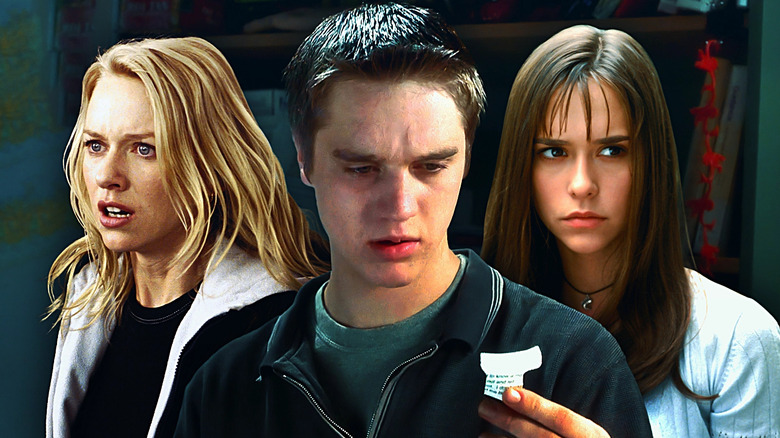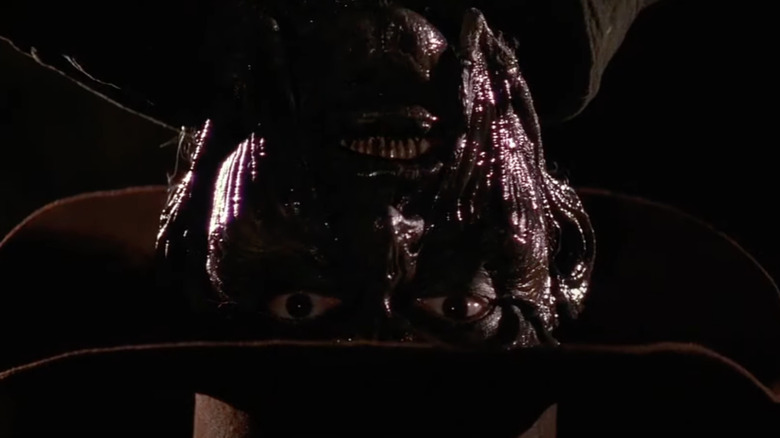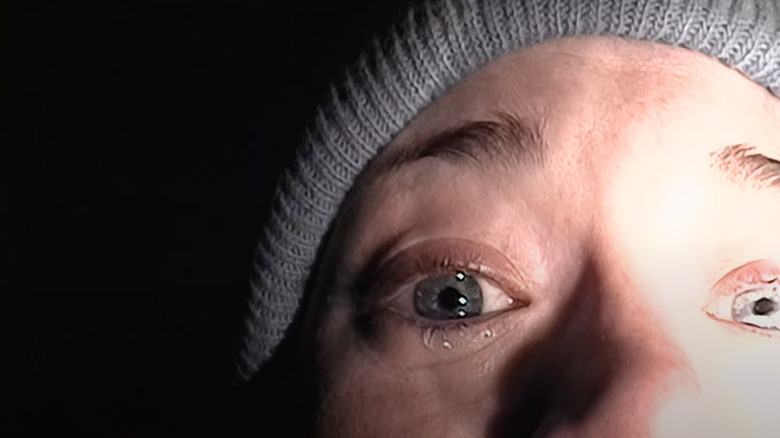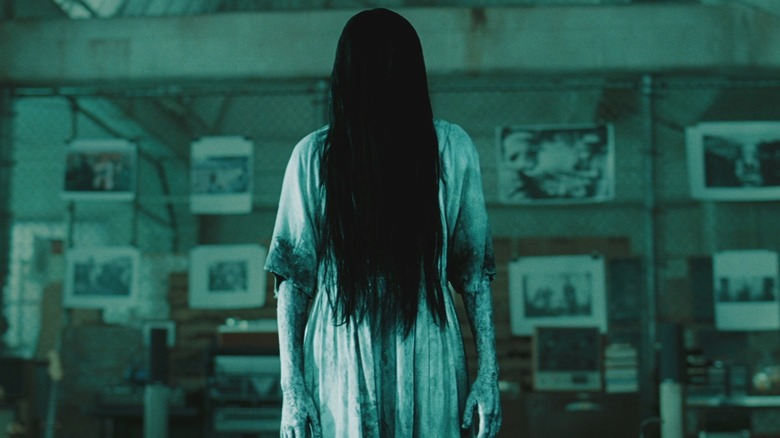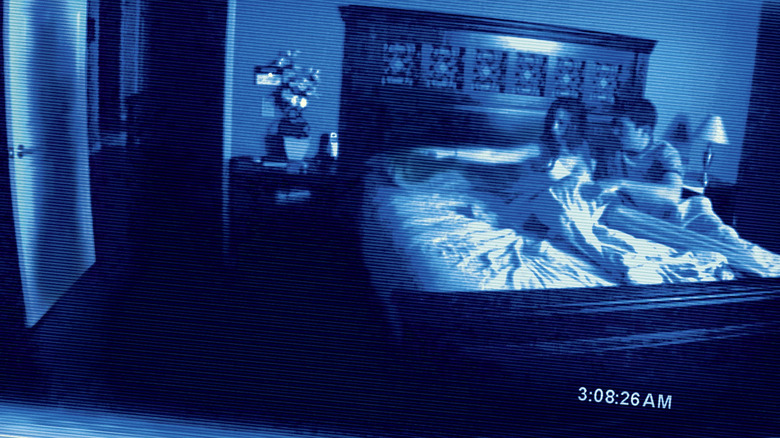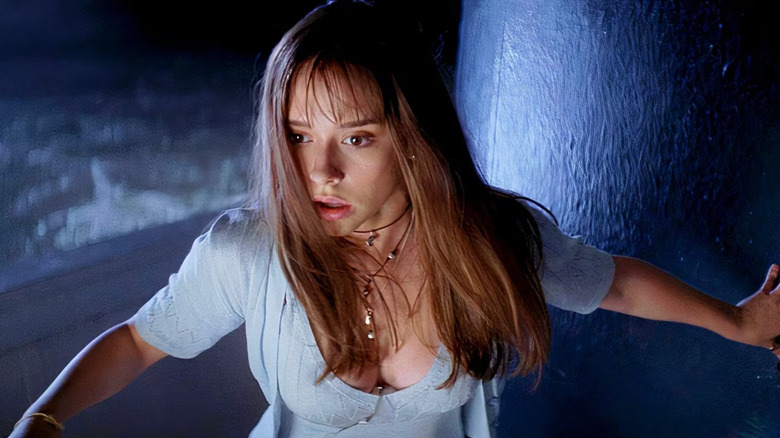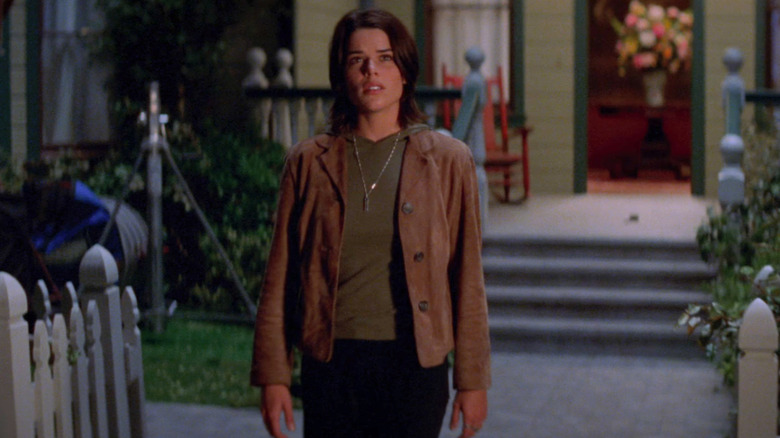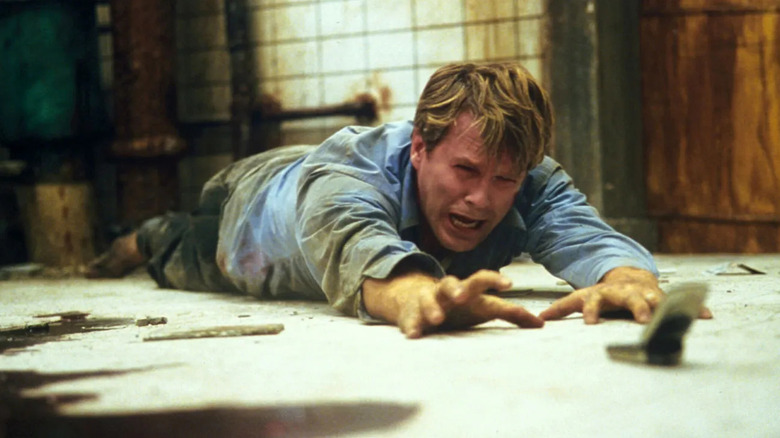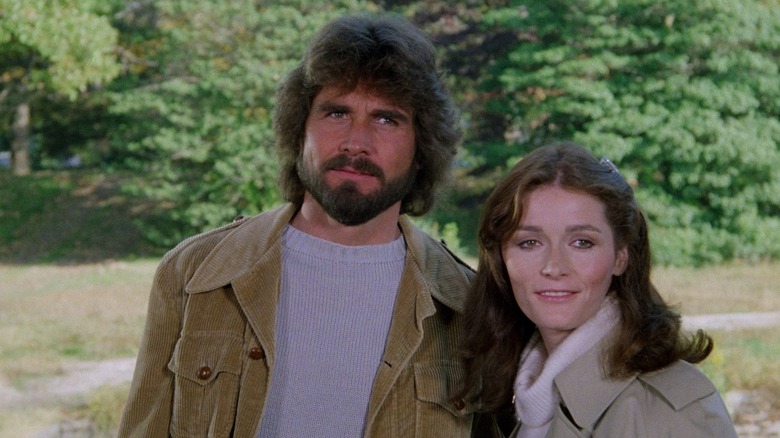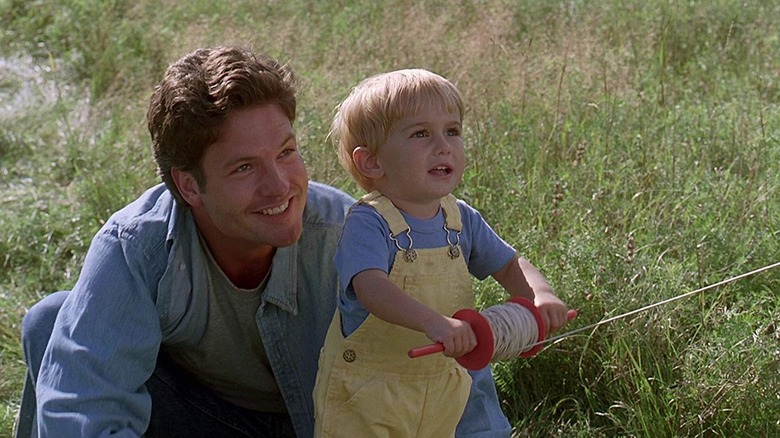10 Hit Horror Movies That Aren't As Good As You Remember
It's no secret that nostalgia paints everything in rosy colors, making it harder to recognize when something we once loved no longer holds up. This happens frequently in the world of film, where childhood emotions blind us to the flaws of a genuinely crappy picture. We don't want to admit that something that once stirred us to our core has lost its luster — and honestly, there's no shame in that. We've all been there.
Still, part of growing up is accepting some hard truths. Steven Spielberg's "Hook" isn't all that great. Michael Bay probably never had it. "Pulp Fiction" and "The Shawshank Redemption" are leagues better than "Forrest Gump." And "Back to the Future Part II and III" never should have happened. There — don't you feel a little better?
No? Well, buckle up. Here's an even tougher exercise: a list of 10 hit horror movies that aren't as good as you remember. Yeah, we're going there. We're pulling the mask off a handful of frauds and exposing them for what they really are — mediocre films that belong in the Walmart bargain bin, not alongside genre classics. Get ready for some hardcore therapy, folks.
Jeepers Creepers (2001)
2001's "Jeepers Creepers" surprised many when it turned a $10 million budget into a $59.4 million box office haul. Clever advertising and a pair of likable actors (Gina Philips and Justin Long) lured audiences to theaters, leading to another respectable tentpole that, sadly, never amounted to much beyond one watchable sequel.
At the time, the consensus was that "Jeepers Creepers" starts out strong but gets weaker as it progresses, showing too much of the monstrous villain en route to a relatively weak third act. And yes, the third act is definitely nothing to write home about, marred by schlocky digital effects and run-of-the-mill action. Watching it all these years later, however, the most shocking part about the picture is that, well, none of it is really good. Philips and Long are clearly newbies to the big screen, turning in inconsistent performances that veer from okay to awful, while several early plot points, such as the kids' desire to go investigate the cellar of a potential murderer, are baffling enough to make the cast of 2003's "The Texas Chainsaw Massacre" laugh with bewilderment. Victor Salva's direction is rather pedestrian. At times, you might feel like you're watching an extended episode of Nickelodeon's "Are You Afraid of the Dark" rather than an actual movie.
That's not to say "Jeepers Creepers" is terrible, but what once felt like a novel thriller now resembles a tacky piece of low-budget horror. No matter what Stephen King says.
The Blair Witch Project (1999)
"The Blair Witch Project" deserves all the accolades it received for turning a simplistic concept into a $248.6 million blockbuster. It popularized the found footage genre and spawned a wave of imitators that dominated multiplexes throughout the 2000s. It's undoubtedly one of the most influential horror films of the modern era.
Yet, removed from the brilliant viral marketing campaign that convinced much of the population the footage was real, "Blair Witch" doesn't hit quite as hard today. Oh sure, it still delivers plenty of freaky moments –especially in its first two acts – many requiring a hefty dose of imagination to fully land. But it lacks a truly standout moment to cement its place among the greats and builds toward a remarkably unsatisfying ending.
In 1999, many viewers felt cheated by the film's ambiguous finale. Today, that same ending feels less like a bold artistic choice and more like a convenient way to avoid a real payoff.
Since then, stronger entries in the found footage genre — like "Cloverfield" and "Chronicle" – have pushed the format further, offering greater thrills and emotional stakes. So while "Blair Witch" remains admirable for its influence and success, stripped of that context, it's a solid — if overhyped — piece of horror.
The Ring (2002)
Whether or not "The Ring" still works depends on how scared you are by the creepy young girl with long hair trope. After years of Hollywood milking that concept dry, it's tough to revisit Gore Verbinski's 2002 picture with the same wide-eyed zeal. Sure, Naomi Watts' performance deserves ample praise, and a few creepy moments still send shivers down the spine.
But the film's moody blue-and-grey aesthetic — a visual hallmark of early 2000s horror — now feels overused and dreary. Familiar genre tropes, clunky early-2000s technology, and a noticeable lack of emotional depth don't help either. Does anyone care about Rachel (Watts), Noah (Martin Henderson), or Aidan (David Dorfman), whose journey amounts to little more than a predictable third-act "gotcha" moment rather than anything significant?
Others may not agree and may even call the film a masterpiece, but the fact is "The Ring" is a victim of its own success, weighed down by the dozens of cheap knockoffs and imitators that watered down its once unique concept. Today, the film feels less like a trailblazer and more like a time capsule of a bygone era.
Paranormal Activity (2007)
When it was first released, "Paranormal Activity" was a scary, clever, and unique independent film tailor-made for the eager-to-be-frightened Friday night crowd. Written and directed by Oren Peli, the picture focuses on slow-building tension rather than out-and-out horror to fulfill its duties. Does it work? Yeah, but is it really as good as we all thought? Not really.
At its core, "Paranormal Activity " is little more than another run-of-the-mill demonic possession movie. Tropes abound. Characters play with Ouija boards, ignore the advice of overburdened paranormal psychologists, and make dumb decisions to ensure the plot goes where it needs to. Eventually, the tense atmosphere gives way to nonstop jump scares that grow tiresome. We get hints at the demon's motives through brief verbal exchanges and a few visual clues but are never entirely sure why the mysterious happenings are, well, happening.
The film doesn't know either, which is probably why it's so vague and also the reason the sequels spun themselves into knots trying to make sense of the franchise's confusing timeline. While the found footage technique is utilized quite well, Peli also uses it to cheat around essential details, like plot and character development, culminating in a frustratingly flat ghost story that hides its rudimentary design behind cheap parlor tricks. Do yourself a favor, ditch this gimmicky slog, and watch Sam Raimi's far more entertaining "Drag Me to Hell" instead.
Final Destination (2000)
Like many on this list, "Final Destination" shocked many viewers with its graphic violence, clever premise, and colorful collection of characters. "Scream" may have revived interest in the slasher film, but "Final Destination" slit the genre by its throat, preying upon humanity's ultimate fear: Death itself.
The success of "Final Destination" led to six additional films, including the upcoming "Final Destination: Bloodlines" (watch the trailer), 10 novels, and even a few comic books. Its Rube Goldberg-styled death sequences paved the way for horror franchises like "Saw," while many of its stars would gain greater fame. James Wong's original "Final Destination" was a game-changer.
There's just one problem: It's not actually that good.
Outside of its high-concept premise, "Final Destination" is surprisingly pedestrian. The performances are bland and forgettable, the effects have aged poorly, and the structure becomes repetitive after the first few kills. The film also raises an unintentional question: why does Death rely on overly complicated, Mouse Trap-style setups to take people out? The answer, of course, is that without them, the movie would be 10 minutes long.
In the end, "Final Destination" is a horror film that's mostly filler — more memorable for what it inspired than for what it actually delivers.
I Know What You Did Last Summer (1997)
"I Know What You Did Last Summer" slashed its way into theaters during the height of the "Scream" craze and capitalized on the newfound interest in the slasher genre, earning a respectable $125 million worldwide against a modest $17 million production budget. Taking its cues from Lois Duncan's 1973 novel of the same, this Jim Gillespie feature benefitted from a strong premise — four hard bodied teens (Jennifer Love Hewitt, Sarah Michelle Gellar, Freddie Prinze Jr., who claimed the picture pushed him to his breaking point, and Ryan Phillippe) get involved with a hit-and-run during a late-night bender only to be summarily picked off by a mysterious masked killer a year later — Kevin Williamson's sharp screenplay, and decent performances from its young cast.
At the time of its release, "Summer" felt like an extension of "Scream," minus the meta-commentary, with hardcore kills, a decent-sized body count, and a few slick twists. Three decades later, time has maimed this pedestrian thriller. Unlike other genre offerings released during the same period, "Summer" is shockingly tame. What starts as a captivating drama about four teenagers grappling with the repercussions of a terrible event quickly devolves into a predictable series of jump scares punctuated by a dull third act. Little wonder this franchise fizzled faster than Freddie Prinze Jr.'s career.
Scream 3 (2000)
Speaking of "Scream," the Wes Craven franchise arguably peaked with "Scream 2," a clever blend of meta-commentary and wicked thrills that stands as one of the strongest sequels to emerge from the '90s. "Scream 3," by contrast, lacks the shock and awe of its predecessors — even as it explores a fascinating and eerily prescient story about women in Hollywood that now feels like a precursor to the #MeToo movement.
Perhaps it's the darker tone or Ehren Kruger's more straightforward screenplay, which lacks the pop culture-infused punch of Kevin Williamson's earlier entries. Or maybe the formula wasn't built to sustain more than two films. Whatever the case, "Scream 3" too often drags, content to rehash familiar beats rather than push the series in a new direction. The climax also hinges on one of those infamous "retcon villain reveals," in which the killer is revealed to have orchestrated the events of the entire trilogy — undermining the motives of previous killers in a way that feels both forced and unnecessary.
Initially, "Scream 3" may have seemed like a fitting sendoff for Sidney Prescott (Neve Campbell), providing the character much needed closure, while offering just enough chills to satisfy fans. But 25 years later, it's clear the third entry is the weakest of the original trilogy by a very large margin.
Saw (2004)
After a gazillion sequels, prequels, reboots, and James Wan's original seven-minute short film, it's fun to revisit the original "Saw" to witness the humble beginnings of a franchise that eventually spiraled into absurdity. That is, until you realize it's not quite as good as you remember. Sure, the big twist still produces gasps, but the 90 minutes leading up to it are pretty damned rough.
Flat performances — especially from Cary Elwes and the usually dependable Danny Glover — undermine the suspense, as does goofy camerawork and far too many plot contrivances. It's clear from the onset that "Saw" desperately wants to be David Fincher's "Se7en," but lacks the brains or creativity to do so. Wan, as he so often does, leans heavily on shock value, favoring grisly imagery over clever storytelling. Attempts at emotion veer into melodrama, while the grimy, green-tinted aesthetic and unrelenting bleakness feel more draining than immersive.
Couple that with low-budget production values, amateurish direction, and clunky dialogue, and "Saw" just doesn't cut as deep as it used to.
The Amityville Horror (1979)
"The Amityville Horror" resides in the stack of iconic horror pictures, notable for its creepy tone, slow-burn chills, and Lalo Schifrin's unsettling score. Based on Jay Anson's 1977 novel – allegedly inspired by actual events — this paranormal feature scared the bejesus out of moviegoers in the late '70s and essentially spawned its own subgenre, resulting in countless books, documentaries, and film sequels, including a 2005 remake that apparently changed Ryan Reynolds forever.
On the plus side, the film's colonial house is still scary as Hell, and the idea of a supernatural entity manipulating a father into murdering his children is chilling in theory. But in execution, "Amityville" isn't as scary as it used to be. In fact, many of the scares, notably when Josh Brolin's character falls into black sludge while trying to rescue his dog, only to be attacked by said dog, are downright hilarious.
"Amityville" packs in every trope imaginable – Catholic priests, ominous flies, wacko nuns, psychic visions, and wide-eyed youngsters who see dead people – but can't overcome its TV-movie production values, stiff acting, and glacial pace to reach the heights of contemporaries like, say, "The Omen," "The Exorcist," or "The Shining." Put it this way: you'll laugh more than scream.
Pet Sematary (1989)
Finally, "Pet Sematary" squanders a solid horror premise with meager production values, often resembling an R-rated Hallmark Channel original rather than a big-screen adaptation of Stephen King's classic novel. The maestro's signature weirdness is on display – he wrote the script despite not like his novel – but much of the disturbing content is neutered by an oddly flat presentation — who cares about demonic children rising from the dead if the characters react with all the gravitas of a stuffed cat?
Is it watchable? Sure. Mary Lambert's film is, at the very least, adequate. The bit where a young child gets crushed by a truck is undeniably harrowing, to say the least, and there is a palpable sense of dread simmering beneath the surface. While the third act occasionally veers into camp — like the bastard offspring of "Child's Play" and "Dennis the Mennis" — it's wild enough to distract from the hammy acting and dollar-store effects.
Still, this concept deserves much better. The idea of a grieving father resurrecting his dead son is ripe with emotional and psychological terror, but the film mostly skirts past it, relying instead on bump-in-the-night scares. Then again, considering the 2019 remake — loaded with a bigger budget and a stronger cast — also failed to generate much excitement (though our own Chris Evangelista thinks it's one of the best Stephen King adaptations), perhaps "Pet Sematary" is more effective as a concept than a film.
